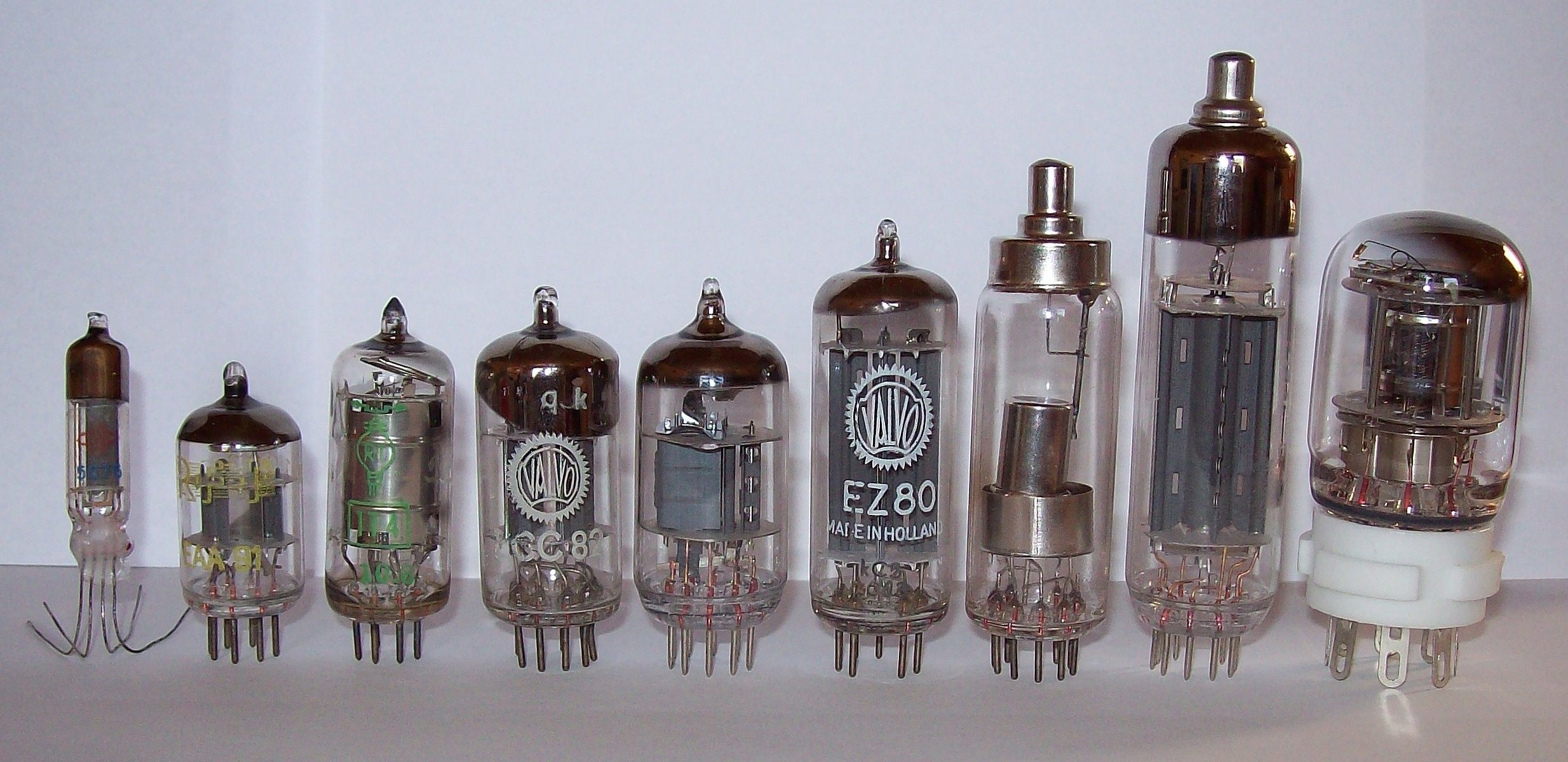|
833A
The 833A is a vacuum tube constructed for medium power oscillator or class B or C amplifier applications. It is a medium-mu power triode with 300 watts CCS or 350 watts ICAS anode dissipation. The long grid and anode leads, plus high internal capacitance, limits this tube to 15-30 MHz maximum frequency. Being medium mu, it is normally not suitable for grounded grid operation. Specifications The 833A is a large tube of the type sometimes known as a "cookie jar" tube, with the envelope nominally measuring 116.8 mm (4.60 in.) in diameter and 219.2 mm (8.63 in.) in height. The 833A contains a thoriated tungsten filament rated at 10 volts and 10 amps. A pair of 833A's with adequate forced air cooling can deliver 1000 watts of CCS RF power operating as a class C amplifier plate modulated stage. A pair of tubes used in a class B modulator can deliver 1800 watts of "peak" AF power in ICAS service with speech, or 1600 watts in CCS service with music or high duty cycle ... [...More Info...] [...Related Items...] OR: [Wikipedia] [Google] [Baidu] |
List Of Vacuum Tubes
This is a list of vacuum tubes or ''thermionic valves'', and low-pressure gas-filled tubes, or ''discharge tubes''. Before the advent of semiconductor devices, thousands of tube types were used in consumer electronics. Many industrial, military or otherwise professional tubes were also produced. Only a few types are still used today, mainly in high-power, high-frequency applications and also in boutique guitar amplifiers. Heater or filament ratings Receiving tubes have heaters or filaments intended for direct battery operation, parallel operation off a dedicated winding on a supply transformer, or series string operation on transformer-less sets. High-power Valve RF amplifier, RF power tubes are directly heated. The heater voltage must be much smaller than the signal voltage on the grid and is therefore in the 5-25 V range, drawing up to hundreds of amperes from a suitable heater transformer. In some valve part number series, the voltage class of the heater is given in the ... [...More Info...] [...Related Items...] OR: [Wikipedia] [Google] [Baidu] |
Vacuum Tube
A vacuum tube, electron tube, thermionic valve (British usage), or tube (North America) is a device that controls electric current flow in a high vacuum between electrodes to which an electric voltage, potential difference has been applied. It takes the form of an evacuated tubular envelope of glass or sometimes metal containing electrodes connected to external connection pins. The type known as a thermionic tube or thermionic valve utilizes thermionic emission of electrons from a hot cathode for fundamental Electronics, electronic functions such as signal amplifier, amplification and current Rectifier, rectification. Non-thermionic types such as vacuum phototubes achieve electron emission through the photoelectric effect, and are used for such purposes as the detection of light and measurement of its intensity. In both types the electrons are accelerated from the cathode to the anode by the electric field in the tube. The first, and simplest, vacuum tube, the diode or Flem ... [...More Info...] [...Related Items...] OR: [Wikipedia] [Google] [Baidu] |
Triode
A triode is an electronic amplifier, amplifying vacuum tube (or ''thermionic valve'' in British English) consisting of three electrodes inside an evacuated glass envelope: a heated Electrical filament, filament or cathode, a control grid, grid, and a Plate electrode, plate (anode). Developed from Lee De Forest's 1906 Audion, a partial vacuum tube that added a grid electrode to the thermionic diode (Fleming valve), the triode was the first practical electronic amplifier and the ancestor of other types of vacuum tubes such as the tetrode and pentode. Its invention helped make amplified radio technology and long-distance telephony possible. Triodes were widely used in consumer electronics devices such as radios and televisions until the 1970s, when transistors replaced them. Today, their main remaining use is in high-power Radio frequency, RF amplifiers in Transmitter, radio transmitters and industrial RF heating devices. In recent years there has been a resurgence in demand for ... [...More Info...] [...Related Items...] OR: [Wikipedia] [Google] [Baidu] |
Modulator
Signal modulation is the process of varying one or more properties of a periodic waveform in electronics and telecommunication for the purpose of transmitting information. The process encodes information in form of the modulation or message signal onto a carrier signal to be transmitted. For example, the message signal might be an audio signal representing sound from a microphone, a video signal representing moving images from a video camera, or a digital signal representing a sequence of binary digits, a bitstream from a computer. This carrier wave usually has a much higher frequency than the message signal does. This is because it is impractical to transmit signals with low frequencies. Generally, receiving a radio wave requires a radio antenna with a length that is one-fourth of the wavelength of the transmitted wave. For low frequency radio waves, wavelength is on the scale of kilometers and building such a large antenna is not practical. Another purpose of modulation ... [...More Info...] [...Related Items...] OR: [Wikipedia] [Google] [Baidu] |

